Imagine waking up every morning in a space that instantly calms your mind and sets a peaceful tone for the day. Bedroom minimalist ideas have become incredibly popular because they transform cluttered, busy spaces into serene retreats that promote relaxation and mental clarity. With a focus on simplicity and functionality, these designs help create a calming environment that makes unwinding effortless after a long day.
In this article, you’ll discover a variety of creative and practical minimalist bedroom ideas that can elevate your space—whether you’re aiming for sleek modern elegance or cozy simplicity. From clever storage solutions to calming color palettes, there’s something here for every style. Get ready to explore inspiring tips that can help you craft a tranquil sanctuary you’ll love to retreat to every night.
1. Embrace Neutral Color Palettes for Calm and Clarity
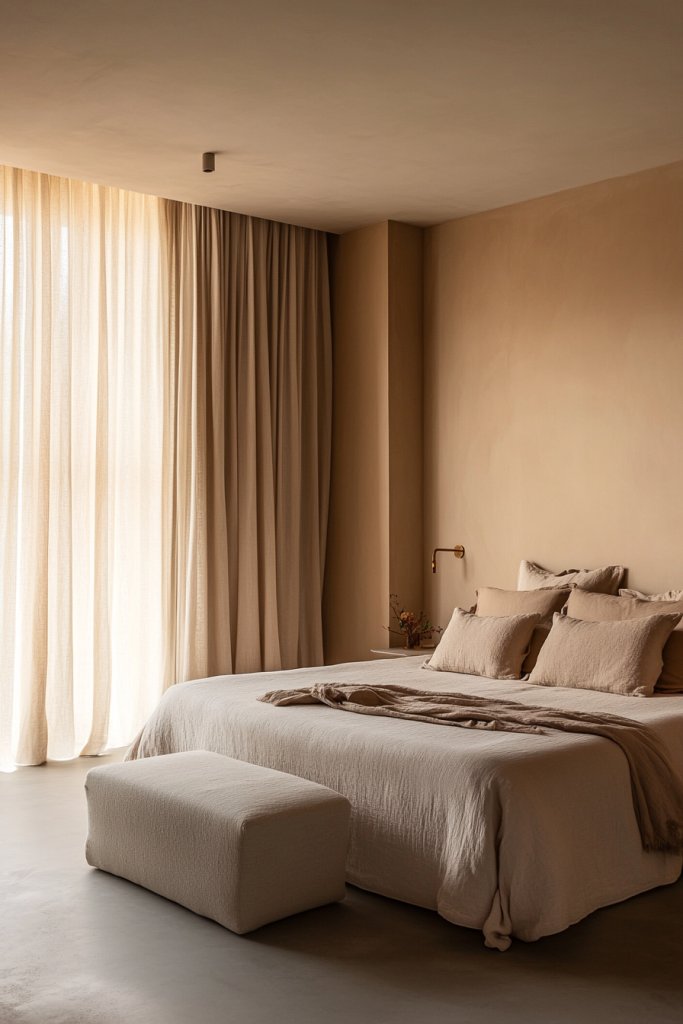
Ever feel overwhelmed by busy, vibrant bedroom colors that make it hard to relax? Using a neutral palette can transform your space into a calming retreat. It’s about creating an environment that soothes your mind and helps you unwind after a hectic day. If your current room feels chaotic, a simple color shift might be just what you need.
Imagine soft shades of cream, warm beiges, and muted taupes that wash over the walls, giving a sense of endless space. The textures of linen and cotton in these tones add warmth and softness, inviting you to settle in. Natural light gently highlights the subtle color variations, making the room feel airy and peaceful. Everything appears uncluttered and cohesive, like a breath of fresh air.
While neutrals work for every season, you can add seasonal touches with throws or pillows in subdued hues, like dusty pinks or muted greens. For small rooms, sticking to light shades maximizes space, but darker neutrals can create a cozy vibe in larger spaces. Scandinavian, farmhouse, or modern styles all embrace this palette but tweak textures and finishes accordingly. It’s easy to adapt neutrals to suit your personality.
Start by choosing a base color—think soft eggshell or warm beige—and paint your walls. Opt for furniture in similar tones or natural wood finishes to keep the look cohesive. Incorporate textiles like cotton sheets, linen curtains, and wool rugs to add tactile interest. Minimal accessories in the same color family prevent visual clutter. Keep surfaces clear and focus on quality materials that reflect light to enhance the calm atmosphere.
Introduce subtle pops of color through textured textiles or decorative accents like a chunky knit throw or a woven basket. Mix matte and satin finishes to add depth without disrupting the calm. Personalize with framed quotes or simple art in neutral frames, avoiding loud patterns. Consistent color tones help you create a serene, personalized sanctuary that feels uniquely yours.
Neutral palettes are timeless and versatile, making your bedroom a peaceful haven. Once you embrace this approach, you’ll find it easier to maintain a clutter-free, harmonious space. It’s a smart choice for anyone craving a serene environment that promotes restful sleep and mental clarity. Ready to swap chaos for calm?
2. Install Wall-Mounted Lighting for a Streamlined Look
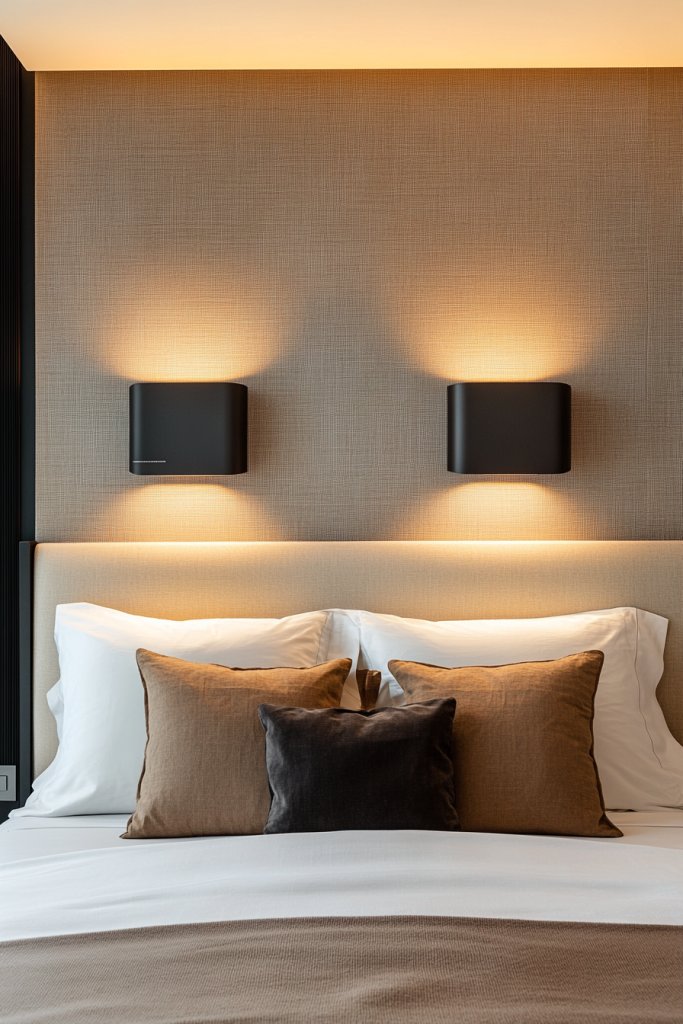
Clunky bedside lamps can clutter your nightstand and make your space feel busy. Wall-mounted lighting offers a sleek, unobtrusive alternative that keeps surfaces clear and enhances your room’s minimalist vibe. Plus, it provides perfect illumination for reading or winding down.
Imagine slim, modern sconces or minimalist pendants fixed directly onto the wall beside your bed. The fixtures cast soft, ambient light that creates a cozy, inviting glow. Their streamlined design means no bulky bases or cords cluttering your space, letting your bedding and decor take center stage. The light’s warm hue complements neutral tones, adding to the tranquil atmosphere.
Choose adjustable sconces for flexibility or fixed ones for simplicity. In rooms with high ceilings, longer pendants add drama; in smaller spaces, compact fixtures keep the look airy. For a softer effect, opt for fixtures with dimmable bulbs or warm finishes like matte black or brushed brass. These lights work well in modern, Scandinavian, or even rustic settings.
Plan placement carefully—install sconces at eye level or slightly above to optimize reading light. Use sturdy wall anchors and wiring designed for your fixture’s weight. Keep electrical cords hidden behind the wall or inside conduit for a clean look, avoiding dangling wires. Pair with dimmable bulbs for adjustable ambiance. Regularly check fixtures for dust and ensure wiring remains safe.
Add a decorative touch with textured lampshades or matte finishes that match your decor. Consider integrating motion sensors or smart bulbs for convenience. Complement wall-mounted lights with layered lighting options like hidden LEDs or candles to customize your ambiance. Keep the look sleek and consistent for a polished finish.
Wall-mounted lighting elevates your room’s style while reducing clutter. It’s a smart solution that combines form and function, making your space feel more open and modern. Once installed, you’ll enjoy a more peaceful, well-lit sanctuary that’s easy to maintain.
3. Maximize Natural Light with Sheer Window Treatments
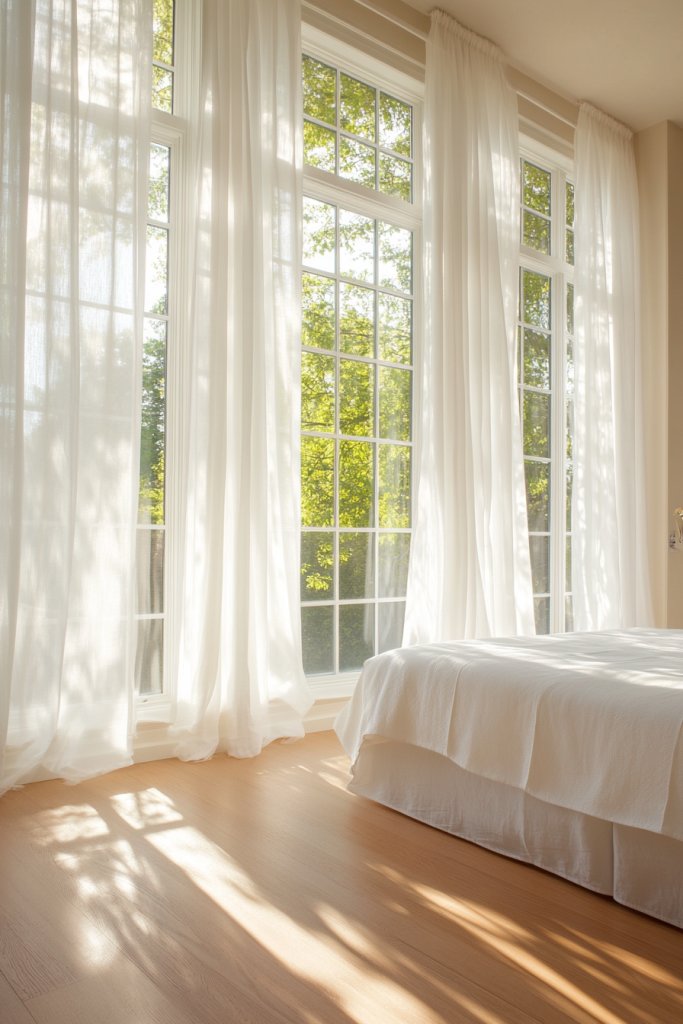
Heavy curtains or dark blinds can make a bedroom feel closed off and gloomy. If you crave a bright, airy space that feels open and refreshing, sheer window treatments are your new best friend. They invite sunlight in while maintaining privacy and adding a soft, diffused glow.
Imagine lightweight, translucent curtains in white or soft beige billowing gently with the breeze. The sunlight filters through, casting gentle patterns on your walls and bedding. The room feels instantly larger, more inviting, and calm. The delicate fabric adds texture without visual weight, making your space feel effortless and bright.
Opt for full-length sheers paired with blackout layers for versatility—use the sheers during the day and close the blackout at night. For smaller windows, choose simple panels that don’t overwhelm the space; larger windows benefit from flowing, floor-length fabrics. Neutral colors work universally, but subtle patterns or textured weaves add interest without cluttering the minimalist look.
Select lightweight, breathable fabrics like voile or linen in neutral shades. Install curtain rods close to the ceiling to elongate the window and create a sense of height. Use tiebacks or rings to keep the curtains open during the day. Keep the fabric clean and lint-free for a crisp, fresh appearance. Regularly wash to maintain transparency and softness.
Add decorative tiebacks or subtle trims for a custom touch. Layer with blinds or shades for added privacy and light control. Choose rod finishes that match other hardware in your room, like matte black or brushed nickel. Keep the overall look simple and elegant for maximum effect.
Maximizing natural light boosts your mood and makes your bedroom a welcoming sanctuary. It’s an easy and affordable upgrade that instantly transforms the space. Once you experience the difference, you’ll wonder why you ever blocked out that beautiful sunlight.
4. Incorporate Minimalist Storage Cabinets or Shelves

Cluttered surfaces and overflowing shelves can sabotage your efforts to create a calm bedroom. Sleek storage cabinets and floating shelves help you organize essentials while keeping visual noise at bay. It’s about making your space look tidy and intentional, without sacrificing style.
Envision a wall-mounted set of narrow, matte-finish cabinets above your bed or dresser, hiding away toiletries or accessories. Alternatively, floating wooden or metal shelves hold neatly folded textiles or functional decor. Everything is within reach but concealed behind smooth, unembellished surfaces, emphasizing simplicity. The result is a clutter-free, balanced room that feels open and organized.
Choose styles that suit your aesthetic—sleek, handleless cabinets for modern minimalism or open shelves for easy access. Use vertical space in small rooms to maximize storage without sacrificing floor area. Incorporate different finishes—matte, gloss, or natural wood—to match your decor. Keep decorative objects minimal and functional, like baskets or boxes, to maintain a clean look.
Start by decluttering and assessing your storage needs. Select streamlined cabinets or shelves that blend into your wall or furniture palette. Install securely with anchors, and consider soft-close mechanisms for durability. Arrange items in uniform order—folded clothes, stacked books, or neatly organized accessories—to keep everything tidy. Regularly revisit to maintain the minimalist aesthetic.
Choose storage options in neutral tones that blend seamlessly with your walls or furniture. Add labels or fabric bins for small items to keep everything in order. Incorporate a few decorative elements like sculptural objects or textured boxes, but keep them minimal. Consistency in style and finish ties the look together.
Smart storage solutions streamline your routine and reduce daily stress. They help you keep only what’s necessary on display, reinforcing a peaceful environment. With a well-organized space, you’ll feel more relaxed and in control every day.
5. Add Textural Variety with Natural Materials

A bedroom that’s all smooth surfaces can feel flat and uninspiring. Introducing natural textures adds depth and warmth, making your space more inviting. It’s about creating a tactile environment that feels cozy yet refined—perfect for unwinding.
Picture a linen duvet cover, a woven jute rug, and wooden accents that bring visual richness to the room. The roughness of the woven basket or the smoothness of a polished wooden side table creates a balanced sensory experience. Natural materials catch the light subtly, adding dimension without clutter. The overall effect is a layered, harmonious space that feels grounded.
Mix different textures—like linen, wool, rattan, and raw wood—for a boho or rustic look. In colder months, add cozy throws and plush rugs; in warmer months, opt for lighter fabrics and woven accessories. Natural finishes work well with both neutral and muted color schemes, enhancing the minimalist vibe. Personal touches such as handcrafted items or eco-friendly textiles elevate the space further.
Choose textiles and decor made from natural fibers like linen, cotton, and wool. Incorporate wooden furniture or accents—think bedside tables, frames, or decorative bowls. Add a jute or sisal rug to anchor the space and tactile cushions or throws for comfort. Use organic and sustainable materials to maintain authenticity. Regularly clean and care for these items to preserve their natural beauty.
Layer textiles in different textures and neutral hues for a cozy, inviting feel. Incorporate handmade or artisanal pieces for a unique touch. Use wooden or stone decorative elements to add visual interest while keeping the look understated. Personalize with a favorite natural fiber throw or handcrafted sculpture.
Natural materials ground your bedroom with organic warmth and simplicity. They enhance your connection to nature and promote calm. When you focus on textures, your space becomes more tactile and inviting—your personal sanctuary.
6. Use Symmetry to Create Balance and Harmony

Disorganized or asymmetrical layouts can make a bedroom feel off-balance and restless. Symmetry creates a natural sense of harmony, making your space feel more peaceful and ordered. It’s about crafting a balanced environment that promotes relaxation and sleep.
Picture matching nightstands on either side of the bed, each topped with identical lamps and decor. The furniture’s placement creates a mirror-like effect that anchors the room visually. The symmetry extends to artwork or architectural features, reinforcing the calm, balanced vibe. The overall look is soothing, with every element in its perfect place.
Use symmetry with furniture placement, decor, or even lighting. In small spaces, balance can be achieved with matching pillows or textiles rather than furniture. For larger rooms, twin beds or dual seating areas emphasize symmetry. Play with visual weight by balancing heavy and light elements in pairs.
Arrange furniture and decor so that items on each side mirror each other, creating a visual equilibrium. Use identical lamps, side tables, or wall sconces for consistency. When adding art or decor, position items symmetrically around the center of the bed or room focal point. Maintain balance with the distribution of textures and colors. Review the overall layout periodically to ensure harmony.
Introduce subtle variations like differing textures or finishes in symmetrical pairs for visual interest. Keep the symmetry consistent across the room for a cohesive look. Use lighting or textiles to emphasize balance and harmony. Personal touches, like matching frames or decorative objects, reinforce the symmetry.
Symmetry enhances your bedroom’s sense of order and peace. It helps your mind relax, knowing everything is in harmony. A balanced space supports restful sleep and a calm daily routine—your personal sanctuary of serenity.
7. Create a Dedicated Meditation or Relaxation Corner

In our busy lives, finding a quiet spot to unwind and reconnect can be tough. A dedicated meditation or relaxation corner transforms a small space into your personal sanctuary. It’s about carving out a peaceful retreat where you can breathe, reflect, and recharge.
Imagine a cozy corner with a simple cushion or a low, minimalist chair, surrounded by soft textiles and gentle lighting. The area is free of clutter, with only a few meaningful objects—perhaps a small sculpture or a textured throw—creating a calming environment. The space invites you to pause and breathe, away from the chaos.
In small bedrooms, designate a corner near a window or quiet spot with a floor cushion or a compact chair. For larger rooms, add a small side table and soft lighting to enhance comfort. Use natural textures like linen, cotton, or wool, and keep decor minimal to avoid distraction. This corner can evolve seasonally with different textiles or lighting setups.
Choose a corner with enough space for a comfortable seat or cushion. Keep the area free of clutter—avoid unnecessary furniture or decor. Use soft textiles and natural materials to create a tactile environment. Add subtle lighting, such as a small lamp or candle, to foster calm. Regularly refresh the space with new textiles or decor that inspire tranquility.
Personalize with items that evoke calm—like a textured blanket or a small sculpture. Incorporate a small shelf or basket for meditation tools or essential oils. Use a consistent color scheme of neutrals or pastels to reinforce the relaxing vibe. Keep it simple and inviting, making it easy to step into your sanctuary anytime.
Creating a dedicated relaxation space empowers you to prioritize mental health and mindfulness. It’s a small investment that yields big calming benefits. Once established, it becomes a vital part of your daily routine, supporting your well-being and peace.
8. Implement Monochromatic Accent Walls for Subtle Depth

A plain wall can make a bedroom feel flat and uninspired. An accent wall in a soft, monochromatic hue adds subtle depth and interest without disrupting the minimalist aesthetic. It’s about creating a focal point that enhances tranquility and visual harmony.
Imagine a single wall painted in a muted, calming tone like dusty pink, sage green, or soft gray. The color creates a gentle backdrop that complements neutral furniture and textiles. The subtle variation in tone adds richness without overwhelming the senses. The result is a layered, sophisticated space that feels both calm and intriguing.
Choose a monochromatic hue that matches or gently contrasts with your overall color scheme. Use matte finishes for a subdued look, or slight sheen for a touch of elegance. In small rooms, a single accent wall can make the space feel larger; in larger rooms, it provides visual interest without clutter. Pair with minimal decor and textiles for a cohesive effect.
Select a paint color within your chosen palette and test patches before committing. Use painter’s tape for clean edges, and consider textured finishes or subtle patterns for added interest. Keep furniture and decor in matching tones to maintain harmony. Avoid contrasting colors or busy patterns that can disturb the minimalist flow. Finish with a matte or eggshell topcoat to reduce glare.
Layer textures with textiles in similar shades—think linen curtains or wool rugs—to add depth. Incorporate subtle decorative elements like throw pillows or art in matching tones. Use lighting to highlight the accent wall, such as wall-mounted fixtures or uplights. Keep accessories minimal to preserve the understated elegance.
A monochromatic accent wall offers a refined way to add visual interest and depth. It elevates your entire space without clutter or distraction. Once you see how a subtle color shift can transform the room, you’ll appreciate the power of simplicity.
9. Use Soft, Ambient Soundscapes for Restful Sleep

Background noise or silence can sometimes make it hard to fall asleep or stay asleep peacefully. Soft soundscapes—like gentle waves, wind, or white noise—create an ambient environment that promotes deep rest. It’s about tuning out distractions and inviting calm into your bedroom.
Imagine a discreet, sleek speaker placed on a shelf or nightstand, emitting a continuous, gentle hum of calming sounds. The room feels enveloped in serenity, with muted lighting and minimal clutter. The soundscape blends seamlessly into the decor, enhancing the tranquil vibe and making your space a true sanctuary for sleep.
Opt for small, wireless, or wall-mounted speakers that don’t intrude on your decor. Choose sound options like nature sounds, ambient music, or white noise, depending on your preference. In cozy bedrooms, keep the volume low to avoid overwhelming the senses. In larger spaces, consider multiple sources for even coverage. Use timers or smart controls for convenience.
Select a high-quality, discreet speaker that matches your aesthetic—sleek, matte, or minimalist in design. Place it strategically near your head or in corners where sound disperses evenly. Use apps or streaming services to select or customize soundscapes. Keep the area free of clutter and dust around the device. Test different sounds and volumes to find what triggers optimal relaxation.
Layer sounds with blackout curtains or textured textiles to block external noise and enhance acoustics. Incorporate calming scents, like lavender or chamomile, to further promote sleep. Use a timer or smart home system to automate soundscapes for bedtime. Keep the setup simple and unobtrusive.
Soft ambient sounds turn your bedroom into a peaceful retreat that supports restful sleep. It’s a simple addition that can drastically improve your nightly routine. Once you experience better sleep quality, you’ll wonder how you ever slept without it.
10. Keep Surfaces Clear of Excess Items
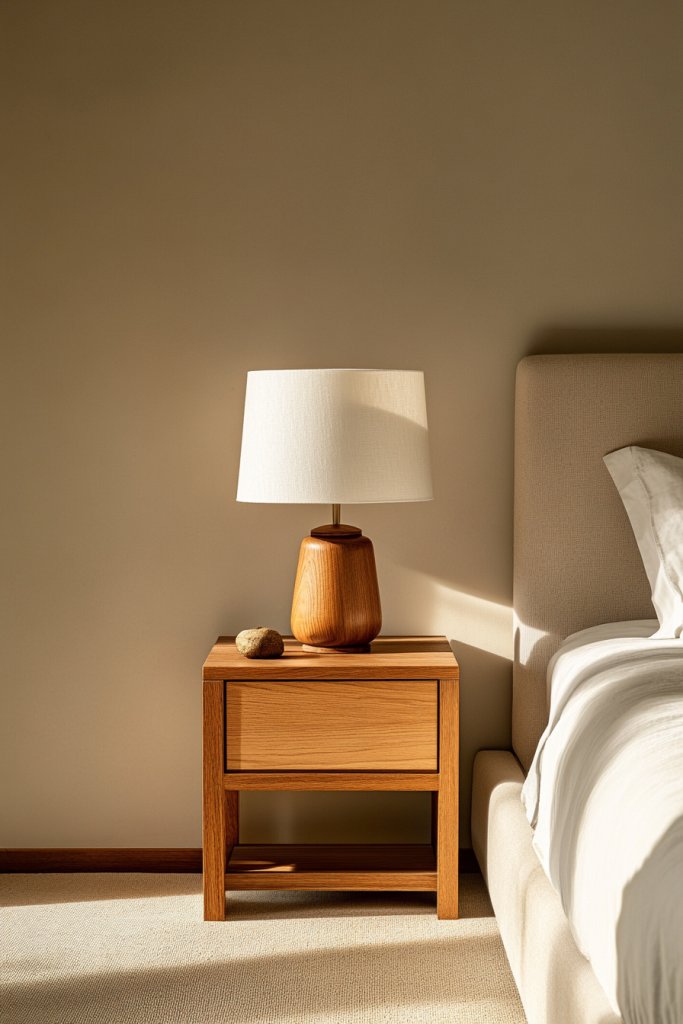
Cluttered surfaces quickly turn a peaceful bedroom into a chaotic mess, making it hard to relax. Keeping surfaces clear is a simple yet powerful way to maintain a calm, minimalist environment. It’s about creating visual space that encourages tranquility and order.
Imagine a pristine bedside table with only a sleek clock or a textured tray holding essentials. The dresser top is free of scattered jewelry or clutter, with only a few carefully curated decor pieces. A clear space reflects a sense of calm, making your whole bedroom feel more open and inviting. The effect is soothing, not sterile.
Use trays, small baskets, or decorative boxes to keep small items organized and contained. Limit decorative objects to a few meaningful pieces—like a sculptural item or a textured box—while avoiding excess. For busy mornings, keep daily essentials in dedicated containers to reduce visual clutter. In larger rooms, create zones for different activities, like reading or dressing, to maintain order.
Regularly declutter surfaces by removing items that aren’t immediately necessary. Use minimalistic organizers that match your decor—think matte black or natural wood. Store seasonal or rarely used items elsewhere. Make a habit of tidying surfaces before bed to start each day fresh. Keep the workspace or bedside clear for a peaceful start or end to your day.
Incorporate textured or sculptural containers for a subtle design statement. Use a single decorative object that holds personal meaning or adds visual interest in a simple way. Choose materials and finishes that complement your overall decor—like matte black, ceramic, or wood. Maintain a routine of quick nightly tidying to ensure surfaces stay clutter-free.
Clear surfaces foster a sense of order and calm, helping your mind relax. It’s a simple habit that enhances your bedroom’s overall serenity. When every item has a purpose and a place, your space becomes a true sanctuary for rest and rejuvenation.
11. Use Simple, Elegant Window Frames and Hardware

Heavy or ornate window hardware can distract from a room’s minimalist beauty. Simple, elegant window frames and hardware subtly enhance your decor while maintaining a clean and cohesive look. It’s about refining the details to create a calm, polished environment.
Picture slim, matte black or brushed nickel window frames with unobtrusive handles. The understated hardware blends into the window design, allowing natural light and view to take center stage. Minimalist trims and clean lines create a sense of harmony and order. The overall effect is a sleek, modern aesthetic that feels effortless.
Choose hardware finishes that match other fixtures—like black or brushed metals—to maintain consistency. For larger windows, opt for slim profiles that don’t overpower the space; smaller windows benefit from simple, unobtrusive frames. If you prefer a softer look, consider painted or textured wood frames in muted tones. The goal is to keep window hardware subtle and functional.
Select hardware with simple, clean designs—avoid ornate or overly decorative options. Measure precisely to ensure a perfect fit and easy installation. Use high-quality materials that resist corrosion and wear. Keep window sills and hardware clean, and periodically check for stability. Use tools like level and drill guides for precise placement.
Add subtle decorative touches like textured pulls or minimalist locks that match your decor style. Keep window treatments simple—think sheer curtains or roller blinds—to complement the hardware. Coordinate hardware finishes with fixtures in your room for a cohesive look. Regularly clean and maintain hardware to keep it looking fresh.
Streamlined window hardware elevates your room’s overall aesthetic and creates a sense of calm. Attention to these small details reflects a thoughtful, minimalist approach. The result is a polished, harmonious space that feels both modern and inviting.
12. Opt for Soft, Textured Rugs in Neutral Tones
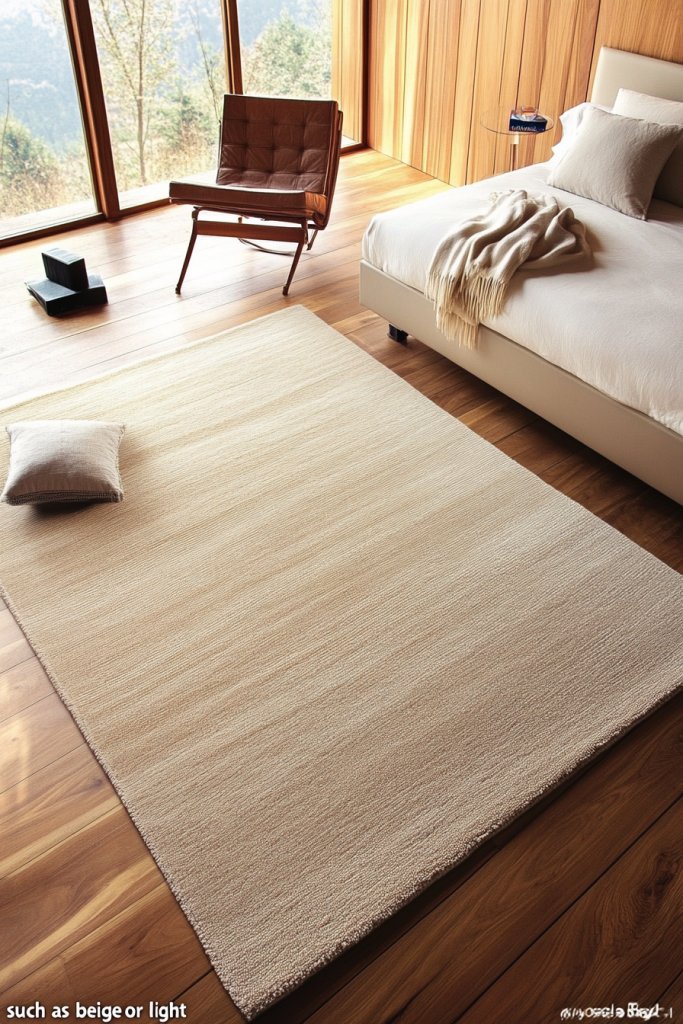
Hard, cold floors or busy patterned rugs can disrupt the peaceful vibe of a minimalist bedroom. Soft, textured rugs in neutral tones add warmth and tactile interest without overwhelming your decor. It’s about creating a cozy foundation that invites you to relax.
Imagine a plush, low-pile rug in a beige or light gray hue layered under your bed. The subtle texture adds depth and softness, making the space more inviting. The muted tone allows your furniture or textiles to shine, maintaining the room’s calm aesthetic. The rug’s gentle surface feels comforting underfoot, especially in colder months.
Choose simple, low-pile rugs in natural fibers like wool or cotton for a cozy, understated look. Larger rugs can anchor the entire room, while smaller runners add interest in specific areas. Stick to neutral shades to keep the look cohesive and calming. Layering with other textiles or adding a subtle pattern can add depth without clutter.
Select a rug that complements your room’s color palette and furniture style. Measure your space carefully to choose the right size—large enough to anchor the room but not overwhelm it. Place the rug so it extends beyond the bed’s edges, creating a visual boundary. Keep the rug clean with regular vacuuming and spot cleaning to maintain its plush appearance.
Add tactile throws or cushions in similar neutral tones for layered comfort. Consider textured or woven textiles for added interest, but avoid loud patterns. Use the rug to define different zones, like a reading nook or meditation corner. Maintain a cohesive look by coordinating textiles and decor.
A soft, textured rug enhances the cozy, calming environment you crave. It grounds your space and encourages barefoot comfort. Once you see how a simple rug can transform your room, you’ll appreciate the power of understated luxury.
13. Maintain a Consistent Design Theme Throughout

A disjointed bedroom with mismatched furniture and decor feels chaotic and stressful. Consistency in design ties everything together, creating a cohesive, peaceful environment. It’s about choosing a style and sticking to it for a truly minimalist, harmonious space.
Picture a bedroom with Scandinavian-inspired furniture—light wood, simple lines, and muted textiles—repeating throughout the space. The decor, textiles, and hardware echo each other, reinforcing the style. The room feels unified, calm, and intentionally curated. Every element supports a cohesive aesthetic that promotes relaxation.
Select a core style—be it Scandinavian, rustic, modern, or industrial—and carry it through all elements. Use matching finishes for hardware, furniture, and textiles. Adapt the style for your space and personality, adding personal touches within the chosen theme. Keep color schemes simple to reinforce harmony.
Start with a mood board or style guide to define your aesthetic. Choose furniture, textiles, and accessories that align with that style. Avoid mixing too many different materials or finishes—stick to a limited palette. Regularly review your decor to ensure it remains cohesive. Simplify your choices to focus on quality and consistency.
Add personal touches like handcrafted textiles or vintage accents that fit your theme. Use artwork, lighting, and accessories that support the overall style—avoid random or out-of-place pieces. Create small vignettes or zones within your room that maintain the theme. This consistency builds a calming, intentional space.
A consistent design theme transforms your bedroom into a curated retreat. It simplifies decorating and helps you make confident choices. When everything aligns, your space radiates calm and intentionality—your personal sanctuary of peace.
14. Declutter Regularly to Sustain a Peaceful Sanctuary
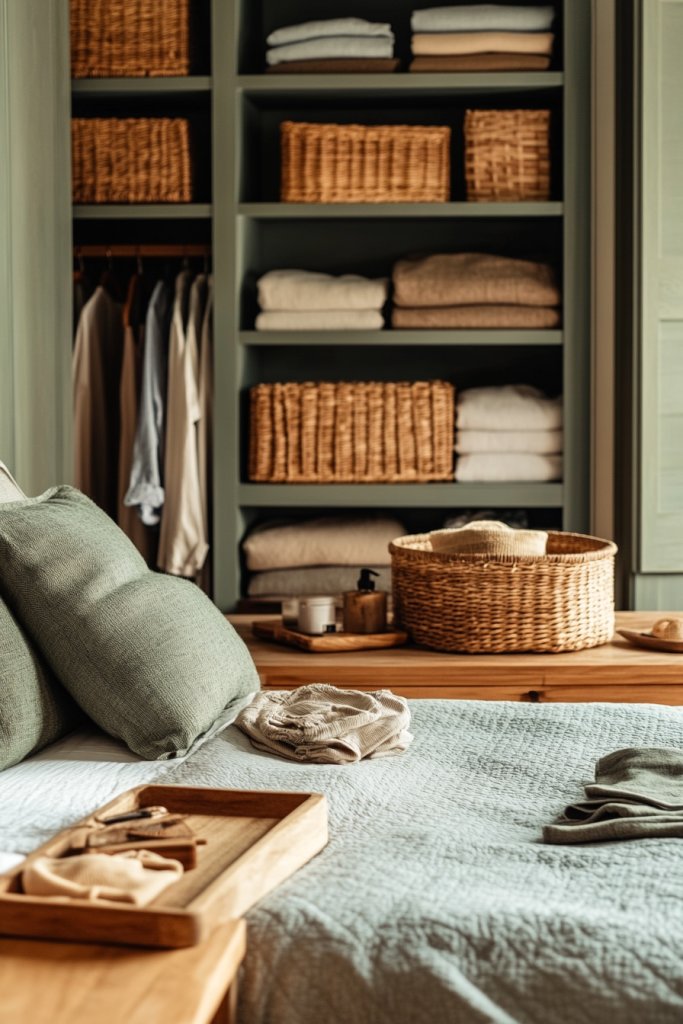
Clutter sneaks into even the most minimalist bedrooms, making it hard to relax and unwind. Regular decluttering keeps your space peaceful, functional, and inviting. It’s about creating a habit that supports long-term tranquility and order.
Imagine a weekly routine of tidying up—removing unused clothes, clearing surfaces, and organizing essentials into neat containers. The room instantly feels lighter, brighter, and more spacious. The visual calm is contagious, encouraging a mindful approach to your environment. The space becomes a sanctuary you genuinely enjoy.
Set a regular schedule—weekly or bi-weekly—to assess and tidy. Use simple storage solutions to keep things out of sight, making decluttering easier. Adopt a ‘one-in, one-out’ rule for accessories or clothing to prevent buildup. Adjust your routine based on seasons or changing needs, keeping the space fresh.
Clear surfaces and storage areas, then evaluate what’s necessary or not. Invest in simple organizational tools—like boxes, baskets, or dividers—that suit your space and style. Regularly reassess your belongings to avoid accumulation. Make decluttering a mindful habit, perhaps as part of your bedtime routine. This ongoing effort preserves your bedroom’s minimalist integrity.
Create a dedicated space for donations or discarding items to keep the process straightforward. Use labels or transparent containers to see what’s inside at a glance. Celebrate small victories—like a cleared drawer or tidy shelf—to stay motivated. Keep your decluttering aligned with your evolving style and needs.
Regular decluttering sustains a peaceful, clutter-free environment that nurtures calm and clarity. It empowers you to maintain a minimalist lifestyle effortlessly. When your space stays organized, your mind follows—making your bedroom a true sanctuary for rest and renewal.
Conclusion
Transforming your bedroom with minimalist ideas can bring a sense of peace and order, making your space both beautiful and functional. Whether you choose a few key decor pieces, smart storage solutions, or calming tones, these ideas are easy to implement and adaptable to your personal style. Don’t hesitate—embrace the simplicity and start creating your own peaceful retreat today. Your ideal minimalist bedroom is just a few simple steps away!
Leave a Reply